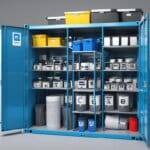Table of Contents
A terabyte (TB) is a unit of digital data that is equal to about 1 trillion bytes. It is used as a measure for storage capacity or the amount of stored data. In decimal notation, a terabyte is exactly 1 trillion bytes. In binary notation, a terabyte is equal to 240 bytes, or 1,099,511,627,776 bytes. The prefix “tera” comes from the Greek word for monster. It would take 728,177 floppy disks or 1,498 CDs to hold 1 TB of information. Computers can now be configured with hard disk drives (HDDs) or solid-state drives (SSDs) that offer more than 1 TB of capacity.
With the exponential growth of digital data, understanding what a terabyte is becomes increasingly important. As technology advances, the need for larger storage capacities becomes critical. Whether you are using a computer, smartphone, or any other electronic device, the amount of data you can store is determined by the terabytes of storage it offers.
In the next sections, we will explore different aspects of terabyte measurements and the historical and future perspectives on terabyte storage. Let’s dive deeper into the base-10 and base-2 standards and how they impact terabyte measurements. We will also take a closer look at the evolution of terabyte storage over time and its implications for data storage.
Base-10 Standard vs. Base-2 Standard for Terabyte Measurements
In the world of computers, storage, and network systems, two standards are used to determine the number of bytes in a terabyte: the base-10 standard and the base-2 standard. These standards play a crucial role in measuring the storage capacity of digital devices.
The base-10 standard, also known as the decimal standard, uses the decimal system to represent data. According to this standard, 1 terabyte (TB) is defined as 1012 bytes, or 1 trillion bytes. In other words, a terabyte in the decimal system is equivalent to a 1 followed by 12 zeros.
On the other hand, the base-2 standard, also known as the binary standard, uses the binary system to represent data. Under this standard, 1 terabyte is defined as 240 bytes, or 1,099,511,627,776 bytes. In binary notation, a terabyte is represented by a 1 followed by 40 zeros.
There are significant discrepancies between these two standards, which have become more pronounced as the storage of data has increased. For instance, when the decimal standard is used, 1 terabyte is equivalent to 1,000 gigabytes (GBs). However, when the binary standard is employed, 1 terabyte is equal to 1,024 GBs.
This difference in interpretation has led to confusion and debates surrounding data storage capacity. It has also given rise to the marketing practice of labeling storage devices using the base-10 standard, while the actual capacity is measured using the base-2 standard.
To illustrate the disparity, consider the following scenario: You purchase a storage device labeled as 1 terabyte, assuming it would contain 1,000 gigabytes of data. However, based on the base-2 standard, the actual storage capacity is 1,024 gigabytes. This discrepancy becomes more noticeable as the storage capacity increases, with larger drives or storage systems having a significant difference in reported capacity depending on the standard used.
In conclusion, the base-10 standard and the base-2 standard serve as crucial measurement systems for determining the number of bytes in a terabyte. Understanding the differences between these standards is essential for accurately assessing and comparing storage capacities in the digital world.
Historical and Future Perspectives on Terabyte Storage
In 1983, IBM released the Personal Computer XT, marking a significant milestone in the history of terabyte storage. This was the first PC to come with a built-in hard drive, offering capacities of 10 MB or 20 MB. It wasn’t until 1991 that consumers could access 1 GB disks, highlighting the gradual growth in storage capacity.
The breakthrough moment for terabyte storage came in 2007 when Hitachi introduced the first 1 TB hard disk drive (HDD). This groundbreaking innovation revolutionized data storage and set the stage for further advancements. Since then, the storage capacity of HDDs and solid-state drives (SSDs) has been on a rapid growth trajectory.
Today, HDDs are capable of storing up to a whopping 20 TB of data, while SSDs can handle an astounding 100 TB. This exponential growth in storage capacity is truly remarkable and paves the way for storing larger volumes of digital data. Moreover, the cost of terabyte storage has also significantly decreased over time, making it more affordable and accessible to consumers.
FAQ
What is a terabyte?
A terabyte (TB) is a unit of digital data that is equal to about 1 trillion bytes. It is used as a measure for storage capacity or the amount of stored data.
How many bytes are in a terabyte?
In decimal notation, a terabyte is exactly 1 trillion bytes. In binary notation, a terabyte is equal to 240 bytes, or 1,099,511,627,776 bytes.
Where does the prefix “tera” come from?
The prefix “tera” comes from the Greek word for monster.
How much information can a terabyte hold?
It would take 728,177 floppy disks or 1,498 CDs to hold 1 TB of information.
What types of storage drives offer more than 1 TB of capacity?
Computers can now be configured with hard disk drives (HDDs) or solid-state drives (SSDs) that offer more than 1 TB of capacity.
What are the base-10 and base-2 standards for measuring a terabyte?
The base-10 standard, which uses decimal notation, specifies that 1 TB is equal to 1012 bytes, or 1 trillion bytes. The base-2 standard, which uses binary notation, specifies that 1 TB is equal to 240 bytes, or 1,099,511,627,776 bytes.
What is the difference between the base-10 and base-2 standards for measuring a terabyte?
The discrepancies between the two standards have greater significance now that more data is being stored. For example, when the decimal standard is used, 1 TB is equal to 1,000 gigabytes (GBs), but when the binary standard is used, 1 TB is equal to 1,024 GB.
When was the first 1 TB hard disk drive (HDD) introduced?
In 2007, Hitachi introduced the first 1 TB HDD, marking a milestone for data storage.
How has terabyte storage capacity evolved over time?
Storage capacity has been rapidly growing since the introduction of 1 TB HDDs and SSDs. HDDs and SSDs are now capable of storing up to 20 TB and 100 TB of data, respectively.
Has the cost of terabyte storage decreased over time?
Yes, the cost of terabyte storage has decreased over time, making it more accessible to consumers.












